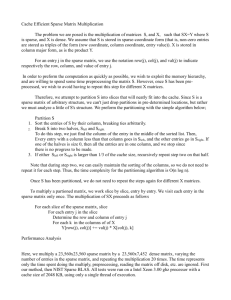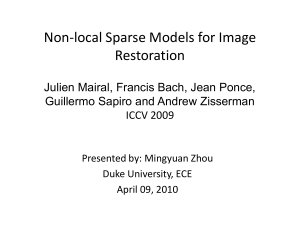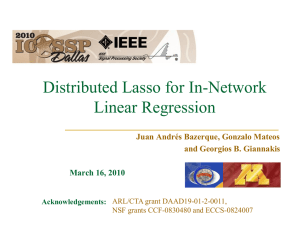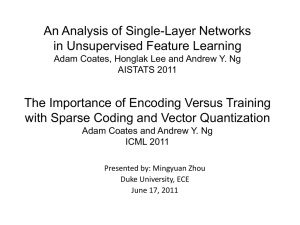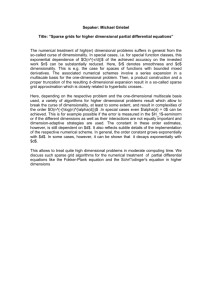Sparse Matrices — Data Structure Matrix Computations — CPSC
advertisement
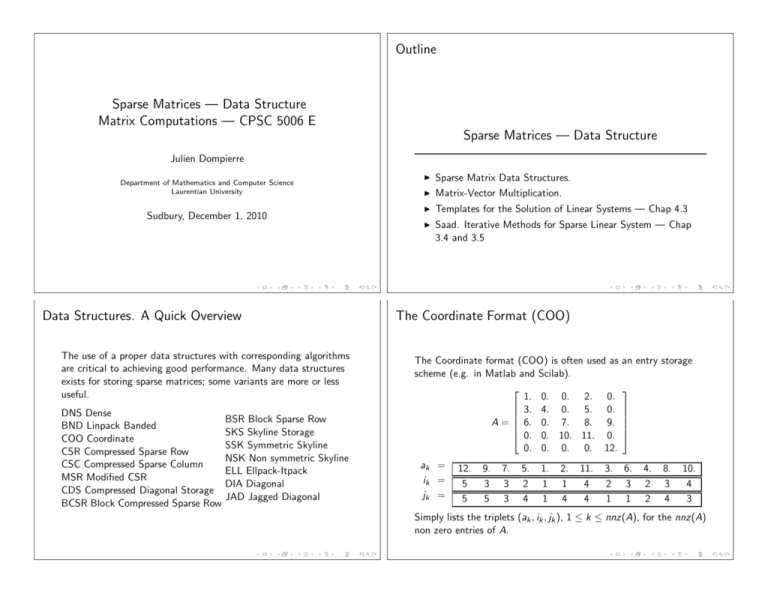
Outline Sparse Matrices — Data Structure Matrix Computations — CPSC 5006 E Sparse Matrices — Data Structure Julien Dompierre Department of Mathematics and Computer Science Laurentian University Sudbury, December 1, 2010 Data Structures. A Quick Overview The use of a proper data structures with corresponding algorithms are critical to achieving good performance. Many data structures exists for storing sparse matrices; some variants are more or less useful. DNS Dense BND Linpack Banded COO Coordinate CSR Compressed Sparse Row CSC Compressed Sparse Column MSR Modified CSR CDS Compressed Diagonal Storage BCSR Block Compressed Sparse Row BSR Block Sparse Row SKS Skyline Storage SSK Symmetric Skyline NSK Non symmetric Skyline ELL Ellpack-Itpack DIA Diagonal JAD Jagged Diagonal ◮ Sparse Matrix Data Structures. ◮ Matrix-Vector Multiplication. ◮ Templates for the Solution of Linear Systems — Chap 4.3 ◮ Saad. Iterative Methods for Sparse Linear System — Chap 3.4 and 3.5 The Coordinate Format (COO) The Coordinate format (COO) is often used as scheme (e.g. in Matlab and Scilab). 1. 0. 0. 2. 0. 3. 4. 0. 5. 0. A= 6. 0. 7. 8. 9. 0. 0. 10. 11. 0. 0. 0. 0. 0. 12. ak = ik = jk = 12. 5 5 9. 3 5 7. 3 3 5. 2 4 1. 1 1 2. 1 4 11. 4 4 3. 2 1 an entry storage 6. 3 1 4. 2 2 8. 3 4 10. 4 3 Simply lists the triplets (ak , ik , jk ), 1 ≤ k ≤ nnz(A), for the nnz(A) non zero entries of A. Matrix-Vector Product with the COO format Matrix-Vector Product with the COO format The sparse transpose matrix vector update y = AT x + y using COO format is expressed The sparse matrix vector update y = Ax + y using COO format is expressed yi k = yi k + a k xj k , 1 ≤ k ≤ nnz(A). yj k = yj k + a k xi k , Algorithm 1 COO sparse matrix vector update. The sparse matrix A is given as nnz(A) triplets (ak , ik , jk ). 1: for k = 1 : nnz(A) 2: y (ik ) = y (ik ) + a(k) ∗ x(jk ) 3: end Algorithm 2 COO sparse transpose matrix vector update. The sparse matrix A is given as nnz(A) triplets (ak , ik , jk ). Then the non zero elements of AT are given by the nnz(A) triplets (ak , jk , ik ). 1: for k = 1 : nnz(A) 2: y (jk ) = y (jk ) + a(k) ∗ x(ik ) 3: end What is the complexity of this sparse matrix-vector multiplication algorithm? So, the sparse transpose matrix vector multiplication can be done without explicitely creating the transpose matrix. The Compressed Sparse Row (CSR) Format Matrix Vector Product with the CSR Format The Compressed Sparse Row (CSR) format is a common working scheme. 1. 0. 0. 2. 0. 3. 4. 0. 5. 0. A= 6. 0. 7. 8. 9. 0. 0. 10. 11. 0. 0. 0. 0. 0. 12. ak jk ki ki = = = = 1. 1 1 1 2. 4 3 3. 1 3 6 4. 2 5. 4 10 12 6. 1 6 13 7. 3 8. 4 9. 5 10. 3 10 1 ≤ k ≤ nnz(A). 11. 4 12. 5 12 Stores non zero entries ak row by row and their column index jk are listed. Then, the index of the first entry k of each row i are stored in ki . Also: Compressed Sparse Column (CSC) + variants The sparse matrix vector update y = Ax + y using CSR format is expressed ki +1 −1 X yi = yi + a k xj k , 1≤i ≤n k=ki 13 Algorithm 3 CSR sparse matrix vector update. The sparse matrix A is given with the CSR format. 1: for i = 1 : n 2: for k = ki : ki +1 − 1 3: y (i ) = y (i ) + a(k) ∗ x(jk ) 4: end 5: end Transpose Matrix Vector Product with the CSR Format The Diagonal (DIA) Format For the sparse transpose matrix vector update y = AT x + y using CSR format, traversing columns of the matrix would be an extremely inefficient operation. Algorithm 4 CSR sparse transpose matrix vector update. The sparse matrix A is given with the CSR format. 1: for i = 1 : n 2: for k = ki : ki +1 − 1 3: y (jk ) = y (jk ) + a(k) ∗ x(i ) 4: end 5: end The Ellpack-Itpack Format 1. 0. 2. 0. 0. 3. 4. 0. 5. 0. A= 0. 6. 7. 0. 8. 0. 0. 9. 10. 0. 0. 0. 0. 11. 12. AC = 2. 4. 7. 10. 12. 0. 5. 8. 0. 0. DA = ⋆ 3. 6. 9. 11. 1. 4. 7. 10. 12. 0. 4. 6. 0. 0. 2. 5. 8. ⋆ ⋆ 2. 0. 0. 0. 5. 0. 7. 0. 8. 9. 10. 0. 0. 11. 12. IOFF = -1 0 2 Block Matrices 1. 3. 6. 9. 11. A= 1. 3. 0. 0. 0. JC = 1 1 2 3 4 A= 3 2 3 4 5 1 4 5 4 5 AA = 1. 5. 2. 6. 3. 7. 4. 8. JA = 1 5 1. 2. 0. 0. 3. 4. 5. 6. 0. 0. 7. 8. 0. 0. 9. 10. 11. 12. 0. 0. 13. 14. 15. 16. 17. 18. 0. 0. 20. 21. 22. 23. 0. 0. 24. 25. 9. 13. 10. 14. 3 5 11. 15. 12. 16. 1 17. 22. 18. 23. 5 20. 24. 21. 25. IA = 1 3 5 Each column in AA holds a 2 × 2 block. JA(k)= col. index of (1,1) entries of the k-th block. 7 Why So Many Sparse Data Structure? The Dompierre’s Law In 1975, Niklaus Wirth wrote the book “Algorithms + Data Structures = Programs”. Performance can vary significantly for the same operation. Storage Scheme / Kernel Compressed Sparse Row Compressed Sparse Column Ellpack-Itpack Diagonal Diagonal Unrolled CRAY-2 8.5 14.5 31 66.5 99 Alliant 7.96 0.6 6.72 9.53 13.92 MFLPS for matrix-vector ope s on CRAY-2 and Alliant FX-8 [From sparse matrix benchmark, (Wijshoff and Saad, 1989)] Best algorithm for one machine may be worst for another. Theorem (Dompierre’s Law) Algorithms + Data Structures + Computer Architecture = Programs



